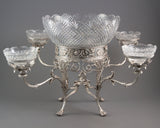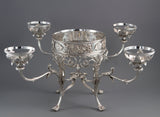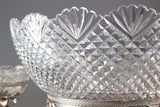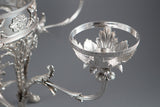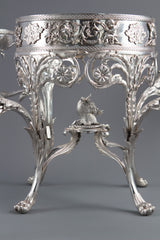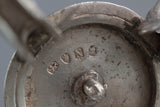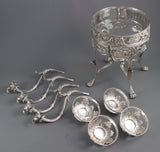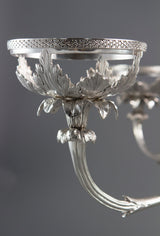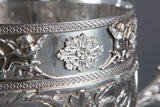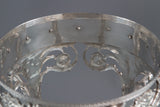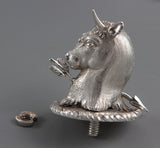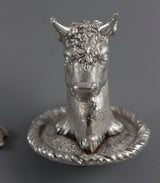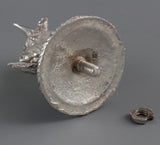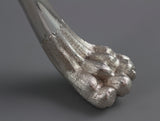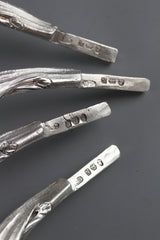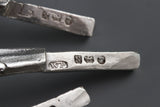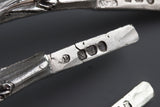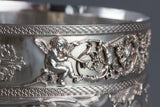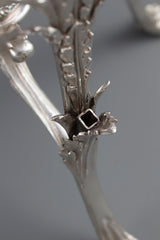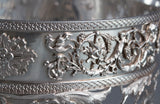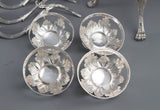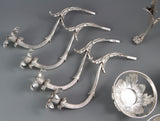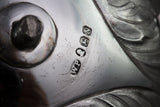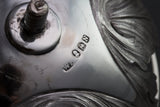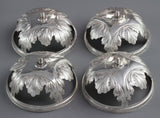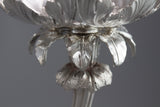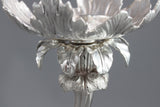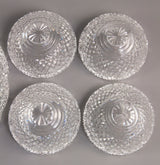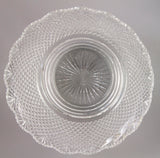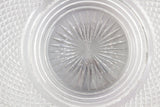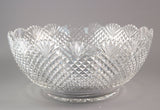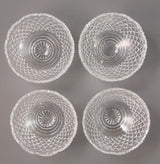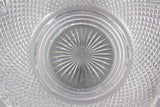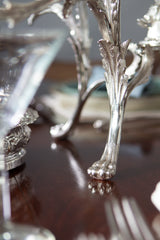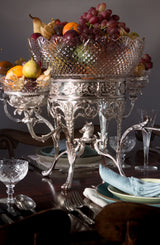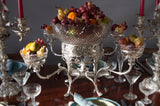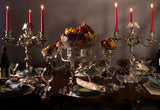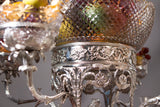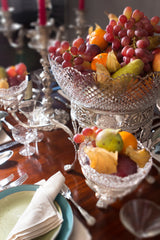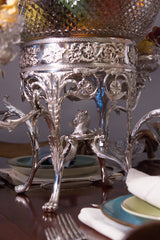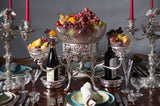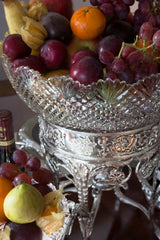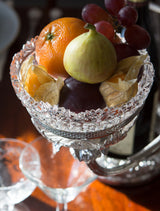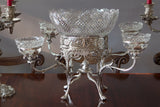An Impressive George III Silver Epergne or Centrepiece, London 1808 by William Pitts
An impressive George III silver epergne in the neoclassical design. The main cylindrical band is adorned with a detachable frieze featuring trumpet playing cherubs, scrolling grapes and foliage and within leaf cast and chased borders, on four scrolling foliate legs with circular flowerheads, joined by four scrolling leaf capped stretchers with a central cast bull's head crest. With four removable branches, decorated with acanthus leaf and reeded decoration ending with cast leaves forming rests for the detachable silver bowl cradles formed from floral decoration. The epergne features 5 cut glass bowls, one large bowl to the center and four smaller bowls with fan cut rims. All standing on four cast paw feet.
All pieces identically hallmarked for London 1808 by the renowned silversmith William Pitts.
This epergne is in first class original condition with no repairs, damage or erasures. Wonderful lustre and patina and of excellent proportions. There are a couple of minor chips to the glass, hardly noticeable. Epergnes of this design are usually considerably lighter and few are of this size and weight, with similar known examples made by other illustrious silversmiths, like Matthew Boulton.
A museum quality piece that makes an attractive focal point for the dining table.
This wonderful piece came from Beaucamp de Haut in Guernsey, the former home of the influential Le Mesurier family.
Height (inc. Glass): 40.5 cm or 16”
Central height (no glass): 29.5 cm or 11.5”
Main diameter (no branches): 22.5 cm or 9”
Diameter (with branches): 69 cm or 27”
Weight of main body: 2100g or 67.5 ozT or 74 oz
Branches: 1740g or 56 ozT or 61.4 oz
Weight of the Cast Bull: 153g or 5 ozT or 5.4 oz
Total weight: 3993g or 128.4 ozT or 140.8 oz
Epergnes or centerpieces were designed for the dinner table or sideboard, for displaying fruit, flowers, sweets, or nuts. The word epergne comes from the French word epargner (to save) space on the table.
Their shape, style, and size vary tremendously, from small vase epergnes that just catered for flowers through to very large examples with many removable silver baskets or glass bowls of varying sizes. They are characterised by having several branching side arms with either small, often pierced, receptacles, attached or suspended, together with a main central bowl or basket. Some epergnes were made with hand-cut crystal bowls designed to catch the colours and internal reflections of candlelight. The added decoration mirrored the style of the period with more ornate examples dating from the Victorian period.
The earliest known examples date from the 1750s, these are very rare now in original condition. The vast majority were made in the 19th century, but there are examples from the 20th century, and they are still being made today for the larger houses.
William Pitts (apprenticed 1769, free 1784) was the son of silversmith Thomas Pitts of James Street, himself known for his exceptional rococo epergnes, and worked with his father from 1806. The firm initially specialised in making large epergnes, pierced baskets and other important large pieces of silver. William Pitts became one of the most pre-eminent chasers of the period and was a leading out-worker used by the Royal goldsmiths Rundell, Bridge & Rundell, with his work appearing on such items as the large, sideboard dishes supplied to the Prince Regent.
He was one of the finest silversmiths and chasers of the nineteenth century, renowned for his neo-rococo work and particularly specialising in ornate cast candlesticks and candelabra in the rococo style and decorated with animals, flowers, shells and scroll-work. He went on to work as a designer, sculptor and chaser for Paul Storr - the most important of all 19th century silversmiths.

